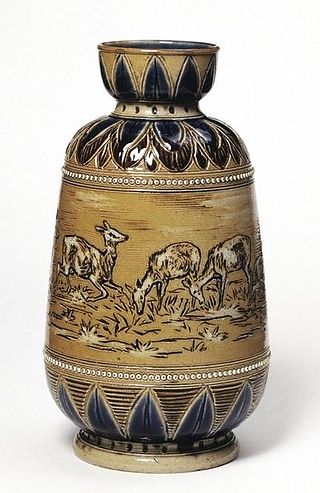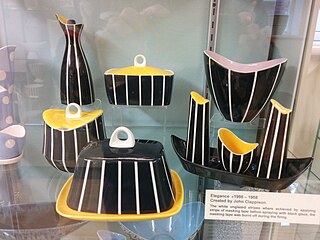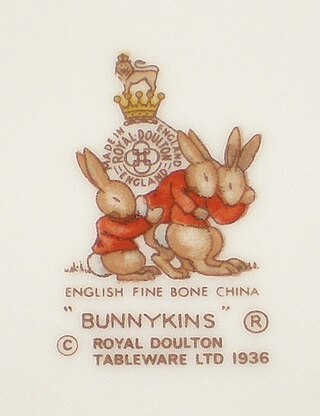Related Research Articles

Hornsea Pottery was a business located in the coastal town of Hornsea in the East Riding of Yorkshire, England. They specialized in tableware with elegant contemporary designs.

The Royal Crown Derby Porcelain Company is the oldest or second oldest remaining English porcelain manufacturer, based in Derby, England. The company, particularly known for its high-quality bone china, having produced tableware and ornamental items since approximately 1750. It was known as 'Derby Porcelain' until 1773, when it became 'Crown Derby', the 'Royal' being added in 1890.

Wedgwood is an English fine china, porcelain and luxury accessories manufacturer that was founded on 1 May 1759 by the potter and entrepreneur Josiah Wedgwood and was first incorporated in 1895 as Josiah Wedgwood and Sons Ltd. It was rapidly successful and was soon one of the largest manufacturers of Staffordshire pottery, "a firm that has done more to spread the knowledge and enhance the reputation of British ceramic art than any other manufacturer", exporting across Europe as far as Russia, and to the Americas. It was especially successful at producing fine earthenware and stoneware that were accepted as equivalent in quality to porcelain but were considerably cheaper.

Royal Doulton is an English ceramic and home accessories manufacturer that was founded in 1815. Operating originally in Vauxhall, London, and later moving to Lambeth, in 1882 it opened a factory in Burslem, Stoke-on-Trent, in the centre of English pottery. From the start, the backbone of the business was a wide range of utilitarian wares, mostly stonewares, including storage jars, tankards and the like, and later extending to drain pipes, lavatories, water filters, electrical porcelain and other technical ceramics. From 1853 to 1901, its wares were marked Doulton & Co., then from 1901, when a royal warrant was given, Royal Doulton.

Mintons was a major company in Staffordshire pottery, "Europe's leading ceramic factory during the Victorian era", an independent business from 1793 to 1968. It was a leader in ceramic design, working in a number of different ceramic bodies, decorative techniques, and "a glorious pot-pourri of styles - Rococo shapes with Oriental motifs, Classical shapes with Medieval designs and Art Nouveau borders were among the many wonderful concoctions". As well as pottery vessels and sculptures, the firm was a leading manufacturer of tiles and other architectural ceramics, producing work for both the Houses of Parliament and United States Capitol.
(Arthur) Leslie Harradine (1887–1965) was one of Royal Doulton's premier, and most prolific, figurine modellers from 1920 until the mid-1950s.

Iittala, founded as a glassworks in 1881, is a Finnish design brand specialising in design objects, tableware and cookware. Iittala's official i-logo was designed by Timo Sarpaneva in 1956.

William John Clappison was an English ceramic and glass designer. Although Clappison is not as familiar as many of his British contemporaries, his work sold in the millions. Initially working out of the Hornsea Studio, partly financed by his father, Clappison would later work for Ravenhead Glass and Royal Doulton. Some of his more popular designs included the Heirloom range for Hornsea Pottery, his Studiocraft vases and his plain white Aphrodite vase, which became a popular wedding present of its time.

Royal Doulton Bunnykins tableware and figurines are popular ceramic designs manufactured as nursery dishes and collectible figurines. The chinaware line originated with artwork by Sister Mary Barbara Bailey, the daughter of Cuthbert Bailey, general manager of Doulton during the 1930s. Unbeknownst to the public, Mary Barbara Bailey was not a professional illustrator, but a nun in the Augustinian Canonesses of the Lateran. Sister Mary Barbara provided illustrations to the designers of Doulton & Co. to be used on tableware. Six Bunnykins figurines were produced based on Sister Mary Barbara's illustrations in 1939 and were designed by Charles Noke. Discontinued during World War II, Bunnykins figurines were not reintroduced until 1969. Bunnykins continued to be produced in England until 2005. Bunnykins figurines and tableware are currently produced in Asia.

Charles Vyse, was an English studio potter, noted for producing colourful figurines of characters seen on London streets.

Art pottery is a term for pottery with artistic aspirations, made in relatively small quantities, mostly between about 1870 and 1930. Typically, sets of the usual tableware items are excluded from the term; instead the objects produced are mostly decorative vessels such as vases, jugs, bowls and the like which are sold singly. The term originated in the later 19th century, and is usually used only for pottery produced from that period onwards. It tends to be used for ceramics produced in factory conditions, but in relatively small quantities, using skilled workers, with at the least close supervision by a designer or some sort of artistic director. Studio pottery is a step up, supposed to be produced in even smaller quantities, with the hands-on participation of an artist-potter, who often performs all or most of the production stages. But the use of both terms can be elastic. Ceramic art is often a much wider term, covering all pottery that comes within the scope of art history, but "ceramic artist" is often used for hands-on artist potters in studio pottery.
John Beswick Ltd, formerly J. W. Beswick, was a pottery manufacturer, founded in 1894 by James Wright Beswick and his sons John and Gilbert in Longton, Stoke-on-Trent. In 1969, the business was sold to Doulton & Co. Ltd. The factory closed in 2002 and the brand John Beswick was sold in 2004. The pottery was chiefly known for producing high-quality porcelain figurines such as farm animals and Beatrix Potter characters and have become highly sought in the collectables market. Pronunciation of Beswick is as at reads, Bes-wick. This information was from employees who worked at the original Beswick factory.

Bing & Grøndahl was a Danish porcelain manufacturer founded in 1853 by the sculptor Frederik Vilhelm Grøndahl and merchant brothers Meyer Hermann Bing and Jacob Herman Bing. The trademark backstamp for Bing & Grøndahl (B&G) porcelains is the three towers derived from the Coat of Arms of Copenhagen. The company's Seagull dinnerware series became known as the "National Service of Denmark" in the 1950s when it was found in one tenth of all Danish households. In 1987 the company merged with its primary competitor, the Royal Porcelain Factory under the name Royal Copenhagen.

The Royal Porcelain Factory in Berlin, also known as the Royal Porcelain Manufactory Berlin and whose products are generally called Berlin porcelain, was founded in 1763 by King Frederick II of Prussia. Its actual origins, however, lie in three private enterprises which, under crown patronage, were trying to establish the production of "white gold" in Berlin from the mid-18th century onwards.

Franciscan Ceramics are ceramic tableware and tile products produced by Gladding, McBean & Co. in Los Angeles, California, US from 1934 to 1962, International Pipe and Ceramics (Interpace) from 1962 to 1979, and Wedgwood from 1979 to 1983. Wedgwood closed the Los Angeles plant, and moved the production of dinnerware to England in 1983. Waterford Glass Group plc purchased Wedgwood in 1986, becoming Waterford Wedgwood. KPS Capital Partners acquired all of the holdings of Waterford Wedgwood in 2009. The Franciscan brand became part of a group of companies known as WWRD, an acronym for "Wedgwood Waterford Royal Doulton." WWRD continues to produce the Franciscan patterns Desert Rose and Apple.

Vernon Kilns was an American ceramic company in Vernon, California, US. In July 1931, Faye G. Bennison purchased the former Poxon China pottery renaming the company Vernon Kilns. Poxon China was located at 2300 East 52nd Street. Vernon produced ceramic tableware, art ware, giftware, and figurines. The company closed its doors in 1958.

California pottery includes industrial, commercial, and decorative pottery produced in the Northern California and Southern California regions of the U.S. state of California. Production includes brick, sewer pipe, architectural terra cotta, tile, garden ware, tableware, kitchenware, art ware, figurines, giftware, and ceramics for industrial use. Ceramics include terra cotta, earthenware, porcelain, and stoneware products.
Charles John Noke, was an English pottery designer and artist who primarily worked for Royal Doulton.

Ceramic art is art made from ceramic materials, including clay. It may take forms including artistic pottery, including tableware, tiles, figurines and other sculpture. As one of the plastic arts, ceramic art is one of the visual arts. While some ceramics are considered fine art, such as pottery or sculpture, most are considered to be decorative, industrial or applied art objects. Ceramics may also be considered artefacts in archaeology. Ceramic art can be made by one person or by a group of people. In a pottery or ceramic factory, a group of people design, manufacture and decorate the art ware. Products from a pottery are sometimes referred to as "art pottery". In a one-person pottery studio, ceramists or potters produce studio pottery.

Millicent (Millie) Jane Taplin (1902–1980) was a British designer and painter of ceramics who spent most of her career at Josiah Wedgwood and Sons (1917–1962). She was trained in painting by Alfred and Louise Powell, and supervised Wedgwood's ceramics painters. She became a designer of decorative patterns in 1929 and by the mid-to-late 1930s was one of the company's main designers, although she did not design pottery shapes. She was one of only two working-class women to become a successful ceramics designer before the Second World War. Her tableware designs were exhibited by Wedgwood at Grafton Galleries in London in 1936, and several of her designs are now on display at the V&A Museum. Her design "Strawberry Hill", with Victor Skellern, was awarded the Council of Industrial Design's Design of the Year Award in 1957.
References
- ↑ "Jo Ledger". The Times (London). 14 August 2010.
- ↑ Dalton, Rodney G. "The History of the Royal Doulton Company". The Dalton Data Bank.
- ↑ Holland, Peter. "Royal Doulton Tableware. Innovation and Awards Galore". Figurines-sculpture.com.
- ↑ "JO LEDGER" (PDF). Connoisseur. 2 (2). 2010 – via Pascoe & Company.